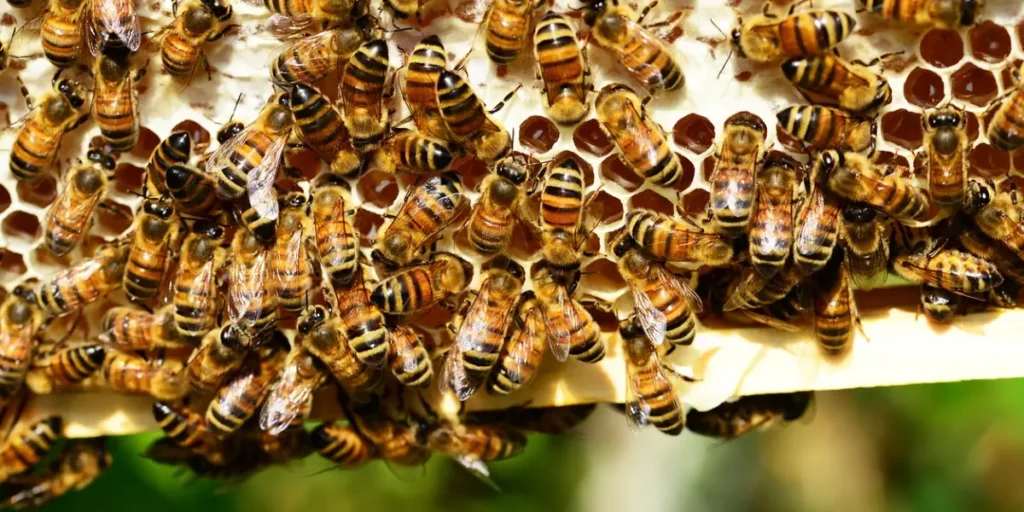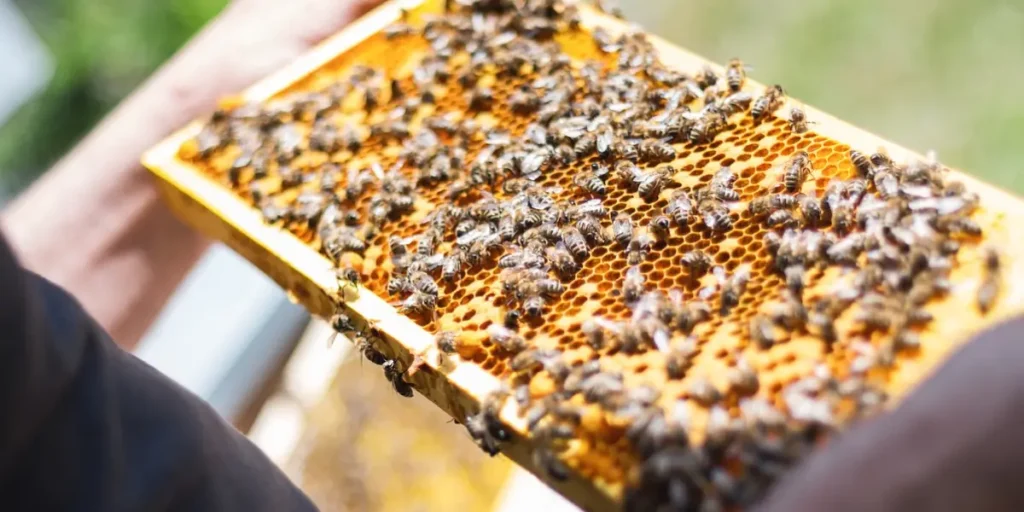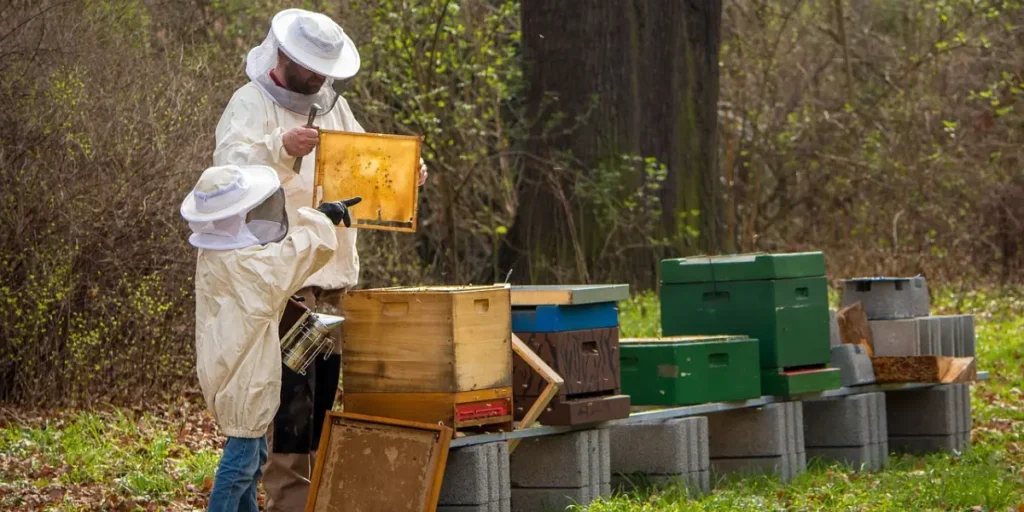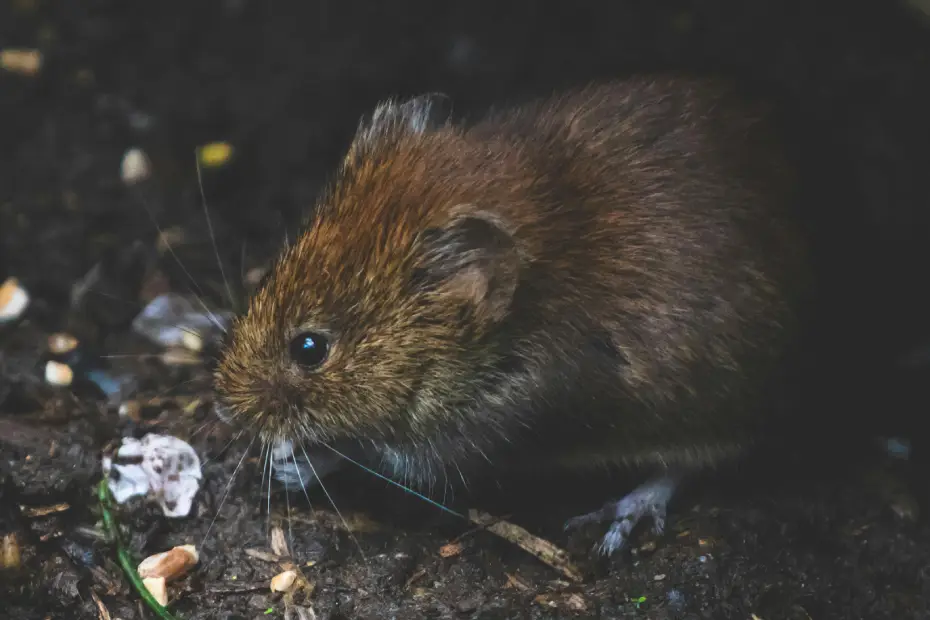Table of Contents
The Rise of Urban Beekeeping: A Sweet and Sustainable Solution
A silent revolution is happening in the middle of busy cities, surrounded by concrete jungles and tall buildings. Once seen as a novelty, urban beekeeping has grown into a vibrant movement that has captured the imaginations of city people looking for a sustainable way of life and a connection to nature. As people become more conscious of the problems bees face and the important role they play in our environment, more and more people are taking up the art of urban beekeeping, turning communal gardens, rooftops, and balconies into havens for these essential pollinators.
However, what is urban beekeeping exactly? It’s the hobby of raising bees in metropolitan areas, including suburbs, cities, and towns. Passionate about bees and wanting to make a positive impact on the environment, urban beekeepers set up and maintain hives in a variety of urban areas, giving bees a secure and caring home and benefiting from pollination and honey production.
Dispelling Misconceptions about Bees and Beekeeping
Prior to exploring urban beekeeping in more detail, it’s critical to dispel a few myths that can discourage others from thinking about taking up this fulfilling hobby. Despite being unjustly linked to fear and stings, bees are actually quite benign animals that are essential to both the health of our planet and our food chain. Although allergic individuals may experience severe pain and even danger from bee stings, the likelihood of stings can be greatly reduced with appropriate protective equipment and safe beekeeping techniques.
Furthermore, against popular belief, urban beekeeping is not as difficult or complex as it seems. Regardless of prior experience or the size of their urban habitat, anyone can become an urban beekeeper with the correct information, tools, and direction. In actuality, urban beekeeping is a great venture for anyone looking for a sustainable and rewarding pastime because it provides a multitude of benefits for both persons and the environment.

Benefits of Urban Beekeeping
There are several advantages to urban beekeeping for the environment and for people. Let’s examine a few of the most notable benefits:
- Pollination: Bees are vital pollinators that fertilize a wide variety of plants, including a large number of fruits, vegetables, and flowers. We can greatly improve the pollination of urban plants and create a greener, livelier cityscape by maintaining bees in urban settings.
- Biodiversity: By giving bees and other pollinators a place to live, urban beekeeping contributes to biodiversity by supporting a greater variety of plant and animal species. This helps to create a more robust and healthy urban ecosystem.
- Local Food Production: Those who practice urban beekeeping can make their own honey, which is a tasty and healthy natural sweetener. This promotes independence and lessens dependency on commercially produced, possibly tainted honey.
- Environmental Awareness: By increasing public knowledge of the value of bees and other pollinators, urban beekeeping encourages people to take action to save these essential animals and their habitats. Furthermore, it fosters a more profound comprehension of the mutual dependence between humans and the environment.
- Community Engagement: Because beekeepers share their knowledge and enthusiasm with others, urban beekeeping can promote a sense of community and connection. Additionally, it may result in partnerships with nearby companies, institutions of higher learning, and other establishments, opening doors for outreach and education.
- Therapeutic Benefits: Amidst the chaos of city life, taking care of bees can be a calming and stress-relieving hobby that gives one a sense of peace and connection to nature.
More individuals are adopting urban beekeeping as a fulfilling and sustainable hobby as its advantages become more widely known. Urban beekeepers are essential to the creation of a greener, healthier, and more vibrant future for everyone because they raise honey and hope in urban areas.
Becoming an Urban Beekeeper: Getting Started
Starting an urban beekeeping journey is a fascinating effort, but before you welcome your first buzzing colony, make sure you’re ready. You may be sure that your entry into the realm of urban beekeeping will be easy and successful because this section will walk you through the necessary procedures to get started.
Essential Tools and Equipment for Urban Beekeeping
To protect the safety and well-being of both the beekeeper and the hives, urban beekeeping requires specialized tools and equipment, just like any other craft. The following is a list of necessities to get you going:
- Beehives: Beehives, the hub of your urban beekeeping enterprise, give your bees a secure and cozy place to live. There are several kinds of beehives that come with pros and downsides of their own. Warre hives, top-bar hives, and Langstroth hives are a few common varieties. Examine the many varieties and select the one that most closely matches your requirements and tastes.
- Protective Gear: It’s critical to protect oneself from bee stings. Invest in a high-quality veil, gloves, and bee suit to protect yourself while inspecting hives and collecting honey.
- Smoker: Bees are pacified with a smoker during hive inspections because it blocks their alarm pheromones. It’s a necessary tool for managing bees effectively and safely.
- Hive Tools: Bee tools are multipurpose instruments utilized for diverse purposes include opening hive boxes, extracting frames, and scraping off propolis, or bee glue.
- Honey Extractor: A honey extractor is a useful instrument for effectively extracting honey from honeycombs if you intend to gather honey.

Choosing the Right Location for Your Urban Beehive
Choosing an appropriate site for your urban beehive is essential to the success of your beekeeping project. When selecting a location, keep the following things in mind:
- Sunlight and Shade: Sunlight helps bees maintain the proper temperature in their hives and makes foraging easier, so they do best in regions with lots of it. But some shade is also essential, particularly in the sweltering summer months. Choose a spot that gets both afternoon shade and morning sun.
- Water Source Proximity: For the purpose of cooling the hive and drinking, bees require access to clean water. Your hive should ideally be situated close to a natural water source, like a creek or pond. If it isn’t feasible, place a shallow water source close to the hive, like a bird bath or a dish with water and stones in it.
- Flight Path Considerations: Bees require unobstructed flight routes to and from the colony. Keep your hive away from busy walkways and anything that can impede their ability to fly.
- Local Regulations and Zoning Laws: Do your homework on zoning rules and local beekeeping requirements before establishing your hive. Certain cities might impose limitations on the quantity of beehives that can be kept or where they can be placed in residential areas.
Selecting the Right Bee Species for Urban Environments
A happy and fruitful beekeeping experience depends on selecting the appropriate bee species for your urban setting. When choosing your bees, take into account the following factors:
- Docile and Gentle Bee Breeds: Choose bee breeds such as Italian, Carniolan, or Buckfast bees, which are renowned for their amiable disposition. Because they are less prone to sting, these varieties are perfect for urban settings where people are more likely to interact with neighbors and the general public.
- Adaptability to Urban Conditions: Certain bee breeds are more suitable for urban settings than others. Take into account breeds that are recognized for their capacity to adjust to fluctuating weather patterns, constrained areas for foraging, and possible exposure to contaminants.
- Honey Production Potential: Even though it might not be the main objective for all urban beekeepers, producing honey is still something to think about. Pick a bee breed that is well-known for producing honey if you want to harvest honey.
You can build a successful urban beehive and enjoy the delicious benefits of beekeeping in the city by carefully weighing these variables and choosing the appropriate equipment, location, and variety of bees.
The Urban Beekeeper’s Journey: Nurturing Your Hive
After putting your beekeeping supplies together, deciding on the best site, and picking the right species of bees, it’s time to start the gratifying process of caring for your urban hive. The crucial procedures for setting up your bee colony, maintaining and inspecting it on a regular basis, and collecting honey and other products from your hard work are all covered in this part.
Installing Your Bee Colony
Purchasing a healthy bee colony from a reliable vendor is the first step towards starting your own urban beehive. A nucleus colony (nuc), which is a tiny, established colony with a queen, brood, and honey reserves, can be purchased instead of a package of bees, which consists of a queen and several thousand worker bees.
After obtaining your hives, it’s time to acclimate them to their new residence. In order to ensure the queen is introduced safely and the bees have access to food and water, this procedure usually entails carefully moving the bees from their package or nuc into the hive.
It’s critical to keep a careful eye on the health and activity of the hive after installation. Keep an eye out for indications of queen activity, such as egg laying, by observing the bees’ flight patterns and making sure the hive is clean and clear of pests and illnesses.
Routine Hive Inspections and Maintenance
You must regularly inspect your hives if you want to keep your bee colony healthy and productive. Throughout the active season (spring and summer), try to check on your hive every 7–10 days; in the fall and winter, check on it less regularly.
Look out for disease or pest indicators during inspections, such as Varroa mites, American foulbrood, or chalkbrood. If you find any issues, deal with them right away, seeking advice from seasoned beekeepers or regional beekeeping associations as needed.
Make sure your bees have access to enough food and water as well. In times when nectar is scarce, you might have to supplement feeding with pollen patties or sugar syrup.
Keeping an eye on the hive population and swarming tendencies is another essential part of hive maintenance. Swarming, a natural process where a portion of the colony leaves the hive with the old queen to form a new one, is caused by an overcrowded colony, which can happen as it grows. You can use swarm management strategies, including dividing the hive or taking out the queen cells, to stop swarming.
Harvesting Honey and Other Hive Products
Reaping the benefits of beekeeping is perhaps best experienced when collecting honey, a tasty and natural sweetener made by bees from nectar they gather from flowers. Using sustainable and ethical extraction methods that put the health of the hive and the welfare of the bees first is crucial when gathering honey.
To preserve its quality and avoid spoiling, honey must be appropriately prepared and kept after it has been extracted. Usually, this entails straining the honey to get rid of any contaminants and keeping it in airtight jars in a dark, cool area.
Beehives yield valuable goods like royal jelly, propolis, and beeswax in addition to honey. Products like candles and cosmetics can be made with beeswax. Bees gather propolis, a resinous material with antibacterial and anti-inflammatory qualities that is utilized in many traditional therapies. Nutrient-rich royal jelly, which is fed to queen bees, is frequently included in dietary supplements since it is thought to provide a number of health benefits.
You may take advantage of the delicious benefits of beekeeping while also supporting the health and well-being of your local ecosystem by taking good care of your urban beehive and using ethical harvesting methods.
The Urban Beekeeper’s Impact: Benefits and Challenges
More than just a pastime, urban beekeeping has the potential to significantly improve our cities and communities. This section will discuss the advantages urban beekeeping has for the environment and society, as well as the difficulties urban beekeepers could face.
Environmental Benefits of Urban Beekeeping
Urban beekeeping plays a crucial role in promoting a healthier and more sustainable urban environment. Let’s explore some of the key environmental benefits:
- Pollination of Urban Flora: A vast range of plants, including several fruits, vegetables, and flowers that flourish in urban settings, depend on bees for pollination. Bee keeping in cities can greatly improve plant health, biodiversity, and the vibrancy of the cityscape by greatly increasing the pollination of urban plants.
- Biodiversity Enhancement: By giving bees and other pollinators a place to live and food sources, urban beekeeping contributes to biodiversity enhancement. As a result, a greater variety of plant and animal species is supported, strengthening and balancing the urban ecology.
- Raising Awareness about Environmental Issues: Raising awareness of the value of pollinators and the difficulties they encounter—such as habitat loss, chemical exposure, and climate change—can be accomplished through urban beekeeping. Beekeepers can encourage others to take action to safeguard these important animals and their habitats by demonstrating the beauty and advantages of bees in urban environments.
Social Benefits of Urban Beekeeping
Beyond its environmental impact, urban beekeeping also offers numerous social benefits that enrich communities and foster a sense of connection and purpose.
- Community Engagement and Education: Urban beekeeping offers a special chance for education and community involvement. Through workshops, demonstrations, and community activities, beekeepers can spread awareness of bees and their importance to our ecosystem by sharing their enthusiasm and expertise.
- Local Food Production and Self-Sufficiency: Those who practice urban beekeeping can make their own honey, which is a sustainable and natural food source. This encourages self-sufficiency and lessens dependency on food products that are mass-produced and might be detrimental to the environment.
- Therapeutic and Stress-Reducing Effects: Amidst the chaos of city life, taking care of bees can be a calming and stress-relieving hobby that gives one a sense of peace and connection to nature. Research have demonstrated that beekeeping can raise general wellbeing, lessen anxiety, and increase mood.
Challenges Faced by Urban Beekeepers
While urban beekeeping offers numerous benefits, it’s important to acknowledge the challenges that urban beekeepers may face.
- Space Limitations and Urban Density: In crowded urban settings, it might be difficult to find good places for beehives. In order to identify areas that provide bees enough sunshine, access to water, and flight patterns, beekeepers must use their imagination and resourcefulness while also adhering to zoning and local ordinances.
- Potential Conflicts with Neighbors or Local Authorities: Conflicts with neighbors or local authorities who may be worried about bee stings or the possibility of swarms can occasionally result from urban beekeeping. Urban beekeepers should take the initiative to speak with their neighbors and respond to any issues they may have.
- Mitigating Risks of Bee Stings and Allergies: Even though the majority of bees are not aggressive, stings do happen and bee venom can cause serious allergic reactions in certain people. In order to reduce the possibility of stings, urban beekeepers should take safety measures, such as donning protective clothing and treating bees with grace and serenity. They ought to be equipped to handle any potential sting situations as well.
Despite these challenges, there are considerably more advantages to urban beekeeping than disadvantages. Beekeepers in urban areas can successfully navigate the complexities of urban beekeeping and enjoy all of its benefits by being proactive in fixing problems and mindful of possible roadblocks.

The Urban Beekeeper’s Community: Connecting and Collaborating
Urban beekeeping is a community-based and collaborative endeavor rather than a solitary one. We will discuss the value of interacting with other beekeepers, expressing your enthusiasm, and picking up tips from their experiences in this section.
Joining Local Beekeeping Associations and Clubs
One of the best ways to enhance your urban beekeeping journey is to join a local beekeeping association or club. These organizations offer a wealth of resources and support for beekeepers of all levels, including:
- Networking and Knowledge-Sharing Opportunities: Making connections with other beekeepers in your community enables you to share experiences, give and receive advice, and gain insight from one another’s triumphs and setbacks.
- Access to Mentorship and Support: A lot of beekeeping societies have mentorship programs that match novice beekeepers with more seasoned mentors who can help and advise them along the way.
- Participating in Community Events and Initiatives: Beekeeping societies frequently plan community activities and events that provide beekeepers a chance to interact with the public and raise awareness of the value of bees. Examples of these activities include honey tastings, educational workshops, and planting pollinator gardens.
Sharing Your Passion for Urban Beekeeping
As an urban beekeeper, you possess a special chance to impart your enthusiasm and expertise to others, encouraging them to value and safeguard bees. Here are a few methods you can help the expanding beekeeping community:
- Educating Others About the Importance of Bees: Many people are ignorant of the difficulties bees encounter and the vital role they serve in our ecology. You may contribute to increasing awareness and motivating people to take action to safeguard bees by disseminating information about them and their significance.
- Hosting Workshops and Demonstrations: To educate people about the fundamentals of beekeeping, hive inspections, honey harvesting, and other beekeeping-related topics, plan workshops or demonstrations. This can be a fantastic method to inspire individuals to establish their own hives and expose them to the world of beekeeping.
- Inspiring Others to Become Urban Beekeepers: Tell about your personal experience beekeeping and the benefits you’ve gained. By demonstrating the advantages of urban beekeeping for people and the environment, you can inspire others to take up this rewarding and long-lasting hobby.
Urban Beekeeping Success Stories: Inspiration and Lessons Learned
The world of urban beekeeping is filled with inspiring success stories of individuals and communities who have embraced this practice and reaped its many benefits. Let’s explore a few examples:
- Rooftop Beekeeping in Bustling Cities: Beekeepers have turned rooftops into bustling bee sanctuaries in places like New York, London, and Tokyo, proving that bees can survive and thrive even in the densest urban settings.
- Community Gardens Transformed into Bee Havens: Beehives are a popular addition to community gardens, as they create thriving ecosystems that benefit the bees as well as the local population. These campaigns frequently include seminars and educational activities that inform people about beekeeping and the value of pollinators.
- Urban Beekeeping Initiatives Promoting Sustainability: The goal of many programs and organizations is to promote urban beekeeping as a way to promote environmental awareness and sustainability. These programs frequently concentrate on public education, offering tools to prospective beekeepers, and supporting laws that encourage urban beekeeping.
Overcoming Challenges and Achieving Thriving Hives
Urban beekeepers frequently have particular difficulties, like space constraints, possible neighbor disputes, and the requirement to modify beekeeping methods for urban settings. But these difficulties can be solved with imagination and ingenuity.
- Creative Solutions for Space Constraints: Urban beekeepers have installed hives on walls, balconies, and rooftops as creative ways to use available space in urban environments. Compact hive designs and vertical beekeeping techniques are also gaining popularity.
- Building Positive Relationships with Neighbors: Building good connections with neighbors and allaying any worries they may have about beekeeping need open conversation and transparency. Fostering friendliness and solidarity among neighbors can also be greatly enhanced by sharing honey or other hive products.
- Balancing Beekeeping with Urban Living: Although urban beekeeping demands attention and dedication, it’s crucial to balance it with other aspects of urban living. Urban beekeepers can successfully incorporate beekeeping into their busy lives by creating a routine and giving hive inspections and care first priority.
These success stories and lessons learned show how adaptable and resilient bees and beekeepers can be in urban settings. Aspiring urban beekeepers might draw inspiration from them, and they also serve as evidence of the beneficial effects urban beekeeping can have on people, communities, and the environment.
Conclusion: The Future of Urban Beekeeping
Urban beekeeping is a developing movement towards a more sustainable and linked urban ecosystem, not just a fad. Urban beekeeping is set to gain even more popularity and potential as people become more aware of the important role pollinators play and the environmental issues they confront.
The Growing Popularity and Potential of Urban Beekeeping
Several factors contribute to the rising popularity of urban beekeeping:
- Increasing Awareness of Environmental Concerns: The problems with our planet’s ecology, like pesticide use, habitat loss, and climate change, are becoming more and more apparent to people. An accessible means for people to help essential pollinators and make a positive impact on the environment is through urban beekeeping.
- The Desire for Local and Sustainable Food Sources: As more consumers look to support local businesses and lessen their carbon footprint, there is an increasing demand for sustainable and locally produced food. One can create their own honey through urban beekeeping, which is a sustainable and natural sweetener with a host of health advantages.
- The Therapeutic Benefits of Connecting with Nature: In the technologically advanced and fast-paced world of today, many individuals yearn for a closer bond with nature. A rare opportunity to engage with nature, urban beekeeping promotes mindfulness, tranquility, and overall wellbeing.
Encouraging More People to Embrace Urban Beekeeping
It is imperative to encourage more individuals to take up urban beekeeping in order to assure its continued success and growth. Urban beekeeping can be promoted in the following ways:
- Dispelling Myths and Fears about Bees: Many individuals have misconceptions and anxieties about bees, which makes them reluctant to pursue beekeeping. We can debunk these misunderstandings and inspire more people to join beekeeping by teaching the public about the kindness of bees and the safety precautions involved in the hobby.
- Highlighting the Accessibility and Rewards of Urban Beekeeping: People of different ages and backgrounds can enjoy the unexpectedly accessible hobby of urban beekeeping, even in small settings. We can encourage more people to take up this rewarding pastime by highlighting the benefits of beekeeping, such as honey production, pollination benefits, and the healing effect of connecting with nature.
- Showcasing the Positive Impact on Communities and the Environment: Urban beekeeping has a good knock-on effect that benefits the beekeepers’ communities, the environment, and themselves. We can show how urban beekeeping has the potential to build a more sustainable and dynamic future for everybody by showcasing the real-world advantages and success stories of urban beekeepers.
Call to Action: Take the First Step Towards Becoming an Urban Beekeeper
Now is the ideal moment to start if you’re interested in urban beekeeping and want to help create a more sustainable and sweeter future. This is how you can begin:
- Research Local Beekeeping Resources and Regulations: To find out more about the laws and procedures of beekeeping in your area, investigate local beekeeping societies, clubs, and internet resources. Make contact with knowledgeable beekeepers who can provide advice and assistance.
- Start Small and Gradually Expand Your Hive: As you develop confidence and experience, start with a single hive and work your way up to larger colonies. Recall that learning beekeeping is a journey, so it’s critical to take your time.
- Embrace the Journey and Enjoy the Rewards: A rewarding and fulfilling hobby, urban beekeeping has many advantages for people as well as the environment. Cultivating honey and hope in the city means accepting the difficulties, appreciating the victories, and relishing the sweet fruits.
We may look forward to a time when cities are alive with the soft buzz of bees, when colorful flowers bloom on balconies and rooftops, and when people live in peace with the natural world as the urban beekeeping movement grows. We can all look forward to a sweeter and more sustainable future if we embrace urban beekeeping.



